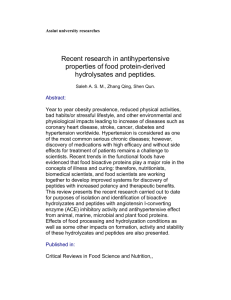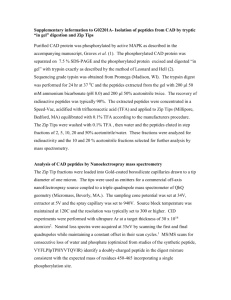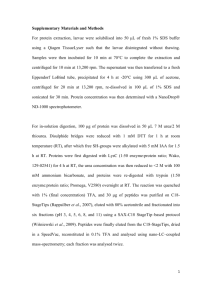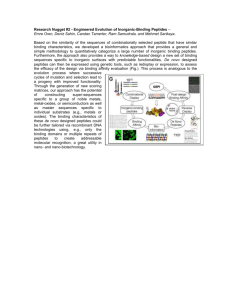Diapositiva 1 - IRB Barcelona
advertisement
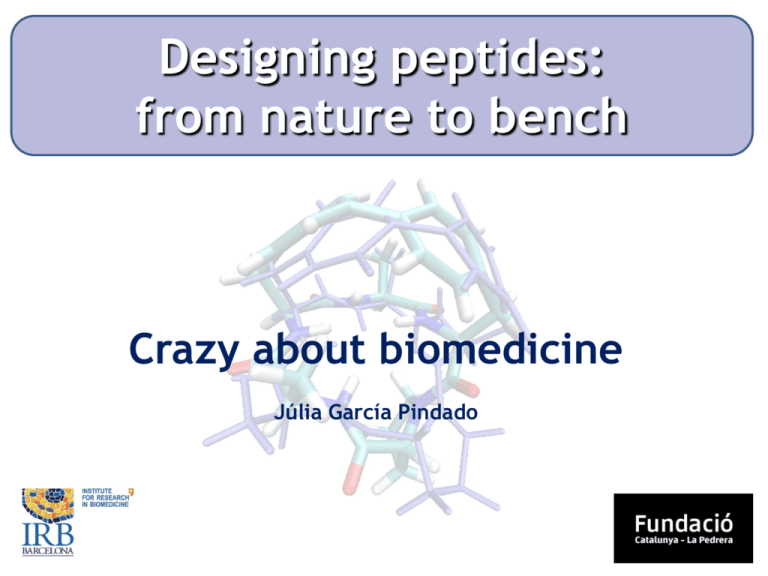
Designing peptides: from nature to bench Crazy about biomedicine Júlia García Pindado Organic chemistry: 5 elements to build us up A brief reminder about proteins and peptides What’s an aminoacid? Chirality A brief reminder about proteins and peptides A brief reminder about proteins and peptides A brief reminder about proteins and peptides How amino acids form proteins? A brief reminder about proteins and peptides Proteins A brief reminder about proteins and peptides Protein structure A brief reminder about proteins and peptides Peptides Peptides as drugs 40 marketed peptides (only 1%) 270 in clinical trials 400 in advanced preclinical trials 15% year growth Peptides as drugs Small molecules Peptides Chemically well defined Low production cost Chemical synthesis Oral administration Specificity Biologics Specificity High production cost Non chemical synthesis Immunogenicity No oral administration Chemically well defined Oral administration Low cost of production Permeability through biological barriers No immunogenicity Specificity Ideal drug candidate Permeability through biological barriers reach the target Stability Solubility Active (nM range) Non toxic Which is the appearance of peptides? Peptide synthesis Solid phase peptide synthesis (SPPS) Developed by Merrifield in 1963 o Fast development o Complex peptides can be reached o 60-70% efficiency Manual SPPS Microwave assisted SPPS Solid phase peptide synthesis (SPPS) Solid phase peptide synthesis (SPPS) Temporary protecting group Permanent protecting group Boc/Bzl Fmoc/tBu Solid phase peptide synthesis (SPPS) Resins Size of the resin beads (80-200 µm) Mechanical and thermal stability Price Swelling Types: Cross-linked polysterene Polyamide Tentagel Soluble Solid phase peptide synthesis (SPPS) Resins Wang SWELLING 2-Chlorotrityl chloride Rink amide Chemmatrix Solid phase peptide synthesis (SPPS) Coupling reagents Name DIPCDI HOAt PyBOP TBTU DIEA Structure Solid phase peptide synthesis (SPPS) Protecting groups Name Structure Removal conditions Stable to the removal of (SPPS) Fmoc 20% piperidine in DMF Boc, Trt, Alloc, pNZ Boc 20-50% TFA in DCM Fmoc, Trt, Alloc, pNZ pNZ 1-6M SnCl2, 1.6mM HCl Boc, Fmoc, Trt, Alloc (dioxane) in DMF Trt Alloc 1% TFA in DCM Fmoc, Alloc Pd(PPh)3 cat., scavengers Boc, Fmoc, Trt, pNZ PhSiH3 in organic solvents iVDde 2% N2H4·H2O - DMF Boc, Fmoc, Trt, Alloc (dioxane) in DMF Trt Solid phase peptide synthesis (SPPS) TFA:H2O:EDT (90:5:5) Fmoc, Alloc Protecting groups Alloc Name Pd(PPh)3 cat., scavengers Removal conditions PhSiH3 in organic solvents (SPPS) 2% N2H4·H2O - DMF 20% piperidine in DMF Boc, Fmoc, Trt, pNZ Stable to the removal of 20-50% TFA in DCM PMe3 in dioxane Fmoc, Trt, Alloc, pNZ - pNB SnCl2 in DMF Boc, Fmoc, Trt, Alloc pNZ 1-6M SnCl2, 1.6mM HCl Boc, Fmoc, Trt, Alloc Acm (dioxane) in DMF I2 (S-S) Trt Trt Bzl Hg(II) (SH) TFA:H2O:EDT (90:5:5) NaOH in organic solvents Fmoc, Alloc Boc, Fmoc, pNZ, Trt, Structure iVDde Fmoc Boc Azide N3 Boc, Fmoc, Trt, Alloc Boc, Trt, Alloc, pNZ Alloc Al 0.1 equiv Pd(PPh)3, 10 Boc, Fmoc, pNZ, Trt equiv PhSiH3 Alloc Pd(PPh)3 cat., scavengers Boc, Fmoc, Trt, pNZ PhSiH3 in organic solvents iVDde 2% N2H4·H2O - DMF Boc, Fmoc, Trt, Alloc Solid phase peptide synthesis (SPPS) The concept of orthogonality Remove only the desired PG without affecting the others Solid phase peptides synthesis (SPPS) Tests to check coupling reactions Kaiser Free amines Chloranil Solid phase peptides synthesis (SPPS) Side reactions Diketopiperazine (DKP) Epimerization: losing the stereochemistry Solid phase peptides synthesis (SPPS) Other inconveniences Aggregation Deletion of residues Problems during the cleavage process Solid phase peptides synthesis (SPPS) Purification Traditional chromatographic purification Solid phase peptides synthesis (SPPS) Purification SPPS enables us to avoid performing several purification steps Reagents Solvent Impurities Beads with the peptide Beads of resin wash Reagents and byproducts Solid phase peptides synthesis (SPPS) Purification HPLC can be used to separate the drug from all the other impurities How can we improve synthetic peptides? To… - Increase stability - Enhance cell uptake and permeability through biological barriers - Improve resistance against proteases N-methylated peptides Non natural aminoacids Cyclic peptides Stapled peptides How can we improve synthetic peptides? Proteases N-methylated peptides Cyclic peptides Stapled peptides Designing peptides Synthesis of natural peptides Synthesis of novel peptides Mimicking nature Aromatic AA(Phe) Variable AA Creating new sequences 1) Envisaging the desired product 2) Proper selection of the strategy 1) Resin 2) PG 3) Final removal of all the PG? 4) Further reactions and/or deprotections after cleavage 3) Carrying out the synthesis Selecting the resin… 2-Chlorotrityl: 1% TFA in DCM Protected peptide acid Wang: 95% TFA Peptide acid Rink amide Chemmatrix: 95% TFA Peptide amide Choosing the suitable PG... Removal in acidic conditions: Boc:25-50% TFA tBu: 90% TFA pNZ:1-6M SnCl2, 1.6mM HCl (dioxane) in DMF Trt: 1% TFA in DCM Removal in basic conditions: Fmoc:20% piperidine/DMF Bzl: NaOH in organic solvents Removal in other conditions: N3 Alloc: Pd(PPh)3 cat., scavengers PhSiH3 in organic solvents Al: Pd(PPh)3 cat., scavengers PhSiH3 in organic solvents Acm: I2 (S-S) Hg(II) (SH) Azide: PMe3 in dioxane Choosing the suitable PG... Choosing the suitable PG... Analysis of the obtained product High Performance Liquid Chromatography (HPLC) Analysis of the obtained product Mass spectrometry (MS) Our lab (Giralt’s group) Design, synthesis and structure of peptides and proteins
